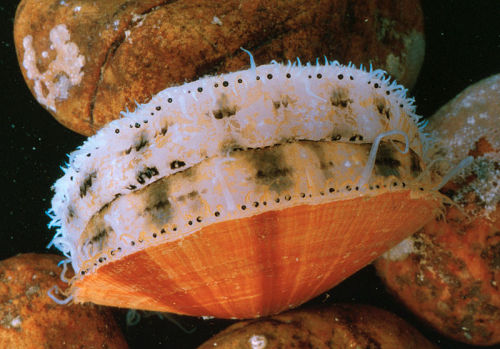- Description
This large and diverse group of bivalves has a single, fused adductor muscle, and a hinge bearing a socket-like arrangement. The foot is greatly reduced and no siphons have developed along the mantle edge. All scallops possess well developed but tiny eyes set along the edge of the fleshy mantle (See link at right, below; Giant Rock Scallop). Scallops respond instantly to changes in light intensity or nearby moving objects.
- Some species of scallops are renowned for their ability to swim. A scallop swims by clapping its valves to ingest water. When the valves close, it then propels water at great force near the hinge, by means of the velum. The velum is a curtain-like fold of the mantle that is used to direct the flow of expelled water around the hinge, much like a pair of movable jets, or lips. Normal swimming is in the direction of the valve opening, but the scallop can sharply change direction with its velum.
- Species in the genus Chlamys are sedentary and live attached by a byssus under rocks in intertidal areas. Scallops are found in all seas, from shallow water to great depths.
- Classification
-
- Class: Bivalvia
-
- Subclass: Heterodonta
-
- Order: Pterioida
-
- Superfamily: Pectinacea
-
- Family: Pectinidae
- Major Genera
-
- Genus: Aequipecten
- Genus: Amusium
- Genus: Argopecten
- Genus: Chlamys
- Genus: Cyclopecten
- Genus: Cryptopecten
- Genus: Delectopecten
- Genus: Hinnites
- Genus: Leptopecten
- Genus: Lyropecten
- Genus: Patinopecten
- Genus: Pecten
- Genus: Placopecten
- Genus: Propeamussium
- Genus: Pseudamussium



|
 Adamussium colbecki
Adamussium colbecki Aequipecten commutatus
Aequipecten commutatus Aequipecten flabellum
Aequipecten flabellum Aequipecten glyptus
Aequipecten glyptus Aequipecten heliacus
Aequipecten heliacus Aequipecten lineolaris
Aequipecten lineolaris Aequipecten opercularis
Aequipecten opercularis Aequipecten tehuelchus
Aequipecten tehuelchus Amusium japonicum
Amusium japonicum Amusium pleuronectes
Amusium pleuronectes Anguipecten gregoryi
Anguipecten gregoryi Anguipecten lamberti
Anguipecten lamberti Anguipecten pacificus
Anguipecten pacificus Anguipecten picturatus
Anguipecten picturatus Anguipecten simoneae
Anguipecten simoneae Anguipecten superbus
Anguipecten superbus Annachlamys flabellatus
Annachlamys flabellatus Annachlamys iredalei
Annachlamys iredalei Annachlamys kuhnholtzi
Annachlamys kuhnholtzi Annachlamys reevei
Annachlamys reevei Annachlamys striatula
Annachlamys striatula Antillipecten antillarum
Antillipecten antillarum Argopecten gibbus
Argopecten gibbus Argopecten irradians
Argopecten irradians Argopecten noronhensis
Argopecten noronhensis Argopecten nucleus
Argopecten nucleus Argopecten purpuratus
Argopecten purpuratus Argopecten ventricosus
Argopecten ventricosus Austrochlamys natans
Austrochlamys natans Azumapecten farreri
Azumapecten farreri Azumapecten ruschenbergerii
Azumapecten ruschenbergerii Bractechlamys adorabilis
Bractechlamys adorabilis Bractechlamys corallinoides
Bractechlamys corallinoides Bractechlamys langfordi
Bractechlamys langfordi Bractechlamys nodulifera
Bractechlamys nodulifera Bractechlamys oweni
Bractechlamys oweni Bractechlamys vexillum
Bractechlamys vexillum Caribachlamys mildredae
Caribachlamys mildredae Caribachlamys ornatus
Caribachlamys ornatus Caribachlamys pellucens
Caribachlamys pellucens Caribachlamys sentis
Caribachlamys sentis Chlamys albida
Chlamys albida Chlamys amandi
Chlamys amandi Chlamys behringiana
Chlamys behringiana Chlamys chosenica
Chlamys chosenica Chlamys cytherea
Chlamys cytherea Chlamys hastata
Chlamys hastata Chlamys islandica
Chlamys islandica Chlamys rosealbus
Chlamys rosealbus Chlamys rubida
Chlamys rubida Chlamys strategus
Chlamys strategus Mimachlamys cloacata
Mimachlamys cloacata Mimachlamys erycina
Mimachlamys erycina Complicachlamys wardiana
Complicachlamys wardiana Coralichlamys madreporarum
Coralichlamys madreporarum Crassadoma gigantea
Crassadoma gigantea Cryptopecten bernardi
Cryptopecten bernardi Cryptopecten bullatus
Cryptopecten bullatus Cryptopecten nux
Cryptopecten nux Cryptopecten phrygium
Cryptopecten phrygium Cryptopecten vesiculosus
Cryptopecten vesiculosus Decatopecten amiculum
Decatopecten amiculum Decatopecten plica
Decatopecten plica Decatopecten radula
Decatopecten radula Delectopecten alcocki
Delectopecten alcocki Delectopecten fosterianus
Delectopecten fosterianus Delectopecten macrocheiricola
Delectopecten macrocheiricola Delectopecten musorstomi
Delectopecten musorstomi Delectopecten polyleptus
Delectopecten polyleptus Delectopecten vancouverensis
Delectopecten vancouverensis Delectopecten vitreus
Delectopecten vitreus Delectopecten zacae
Delectopecten zacae Dentamussium obliteratum
Dentamussium obliteratum Equichlamys bifrons
Equichlamys bifrons Euvola chazaliei
Euvola chazaliei Euvola galapagensis
Euvola galapagensis Euvola laurenti
Euvola laurenti Euvola marensis
Euvola marensis Euvola papyracea
Euvola papyracea Euvola perula
Euvola perula